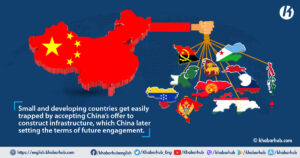By John P. Ruehl 19 November 2023
In October 2023, amid celebrations commemorating the 10th anniversary of China’s Belt and Road Initiative (BRI) in Beijing, Pakistan and Chinese leaders signed a multibillion-dollar deal for a railway project. As a pivotal component of China’s efforts to promote economic integration and develop infrastructure abroad, Pakistan has received significant developmental assistance from Beijing through the $62 billion China-Pakistan Economic Corridor (CPEC).
Nevertheless, Western nations and financial entities have also been strategically maneuvering in Asia, with the International Monetary Fund (IMF) approving a $3 billion loan for Pakistan in July, “saving it from defaulting on debt.” Other countries in the region are experiencing similar competition. Bangladesh, for instance, inaugurated the BRI-linked Padma Bridge Rail Link in October, and weeks later received a $395 million loan from the EU. That month, Sri Lanka struck a debt deal with China, while the U.S. extended a $553 million loan for port construction in Colombo in early November.
As competition over infrastructure and investment has grown in recent years, standoffs between Western and Chinese lenders over debt restructuring and relief have intensified. Lenders hesitate to offer relief packages, fearing that one creditor’s concession might allow a debtor country to use that relief money to pay off others. These impasses underscore the challenges being faced by the decades-old Western-dominated financial system and lending initiatives.
The foundation of this system was laid at the Bretton Woods Conference in 1944. The meeting established the IMF to ensure stability of the international monetary system and offer policy advice and financial assistance to countries in economic crisis. It has since grown and comprises 190 member states, while its “sister organization,” the World Bank, was created simultaneously and has grown to include 189 member countries. The World Bank focuses more on long-term assistance through loans and grants, supporting infrastructure and poverty reduction in developing countries.
Efforts to democratize these institutions have been made, but both the IMF and World Bank still remain under significant Western influence. Western countries are overrepresented on the IMF’s board and voting arrangements, while all the IMF’s managing directors have been European. All the World Bank’s presidents except for Bulgarian national Kristalina Georgieva, who served as acting president in 2019, have been U.S. citizens, and the voting shares of the bank have not been rearranged since 2010. Both institutions are based in Washington, D.C.
In addition to the IMF and World Bank, other Western-dominated (or heavily influenced) multilateral development banks and institutions include the Paris Club, the European Investment Bank, the Inter-American Development Bank, the European Bank for Reconstruction and Development, and the Asian Development Bank. Government initiatives like USAID, the U.S. Trade and Development Agency (USTDA), and the U.S. International Development Finance Corporation, as well as private banks, also play prominent roles in advancing Western economic interests.
China’s role in multilateral banks like the IMF and World Bank has expanded as its economy has grown. But Beijing continues to criticize the current global debt governance system as “dominated by the ‘Paris Club-IMF-World Bank’ structure of the West,” and has chosen to create its own path to expand its economic influence globally.
China’s state capitalism offers a unique alternative to Western infrastructure and development initiatives for the first time in decades. Through its robust, globally integrated economy, technological expertise, and extensive industrial power, Beijing can help fund and build projects on a scale that rivals the West in a way not even the Soviet Union could achieve. Furthermore, Chinese assistance does not require political and economic reforms typically attached to Western developmental initiatives.
China’s approach has seen significant success. It has become the world’s largest creditor since 2017, and is lending more than the IMF, World Bank, and Paris Club combined, said Brent Neiman from the U.S. Department of the Treasury in September 2022. With $1 trillion spent and more than $2 trillion in contracts, China’s BRI has transformed global trade routes and economic development and is even garnering interest from the Taliban.
A Center for Global Development 2020 study estimated that Chinese loans generally have a 2 percent interest rate, in comparison to 1.54 percent for the World Bank’s concessional loans, and the penalties for late repayments have increased since 2018, according to AidData. Nonetheless, most BRI partner countries view China’s project positively.
Source: Globetrotter

